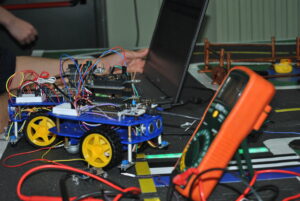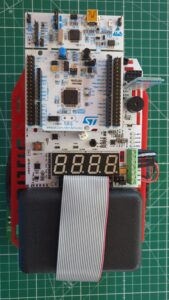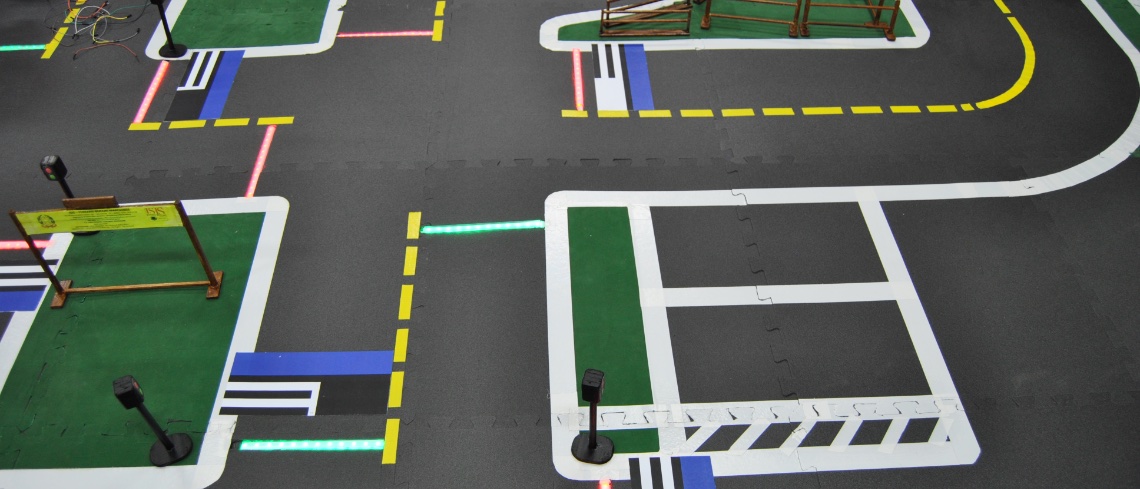To improve the accessibility of our content, please find the audio version of this blog post.
How can teachers inspire students to pursue a career in embedded systems? Roobopoli believes the answer lies in making them build a smart city and a smart car. Roobopoli is a project led by Perlatecnica, a not-for-profit association promoting technological literacy, and Bluenet, a member of the ST Partner Program. The initiative aims to help high school and college students learn the fundamentals of embedded systems. The project itself revolves around the Robokart and a traffic light module. The former is a kit enabling students to build a small smart vehicle. The latter is a module that controls the flow of the Robokarts in the simulated city. Hence, the program itself is quite extensive as it tackles microcontrollers, IDEs, sensors, motor control, and more. It is also incredibly flexible as teachers can adapt the free-to-download curriculum to fit a wide range of ages.
Driving Robokart

Bluenet already managed to deliver the Robokart kit to more than 200 schools across Italy. The company also continues to update its platform, but each kit uses a NUCLEO-F401RE as a motherboard. The first version stacked an X-NUCLEO-IKS01A2 sensor board and an X-NUCLEO-IHM12A1 to control the motor spinning the wheels. The kit’s latest version combines all of the features of the daughterboards onto one PCB that even includes an IR sensor and a time-of-flight sensor board (X-NUCLEO-53L0A1). The last two boards help the car navigate the roads of Roobopoli and obey traffic lights. Robokart ensures teachers get all the parts they need in one affordable package. As a result, more students can work on their car, making the learning experience more relatable. After the success Bluenet met in Italy, the company is now talking with American schools to expand its reach.
Running Roobopoli

To ensure that Roopoboli would attract a wide range of students, its creators made the initiative very flexible. For instance, the curriculum uses the Mbed APIs to simplify programming significantly. Even students with no coding background can rapidly learn how to assign pins and write simple applications. Instead of using a language that’s too limited, students learn with tools used by engineers working on real-world industrial applications. Bluenet also shared how university professors use the same kit to teach their students about sensor fusion and apply it. Similarly, some college courses use the kit to talk about PID (Proportional, Integral, and Derivative) algorithms because the smart car shows how they work in real-world examples. The project is also entirely open-source, and its backers encourage schools to share their code, thus creating a community.
What’s Next?
The next step for Bluenet is to continue improving the Robokart and expanding its potential as a teaching tool. The company is looking into using an STM32WB to introduce wireless communication. The people behind Roobopoli are also evaluating the addition of NFC, creating STM32CubeMX projects, or introducing students to microPython. Such improvements are possible because Robokart remains highly modular, thus enabling schools to adapt the tool to their curriculum. Bluenet is also working with ST in a proof-of-concept lab, in Naples, Italy, to help local schools see the smart city in action to help them make the initiative a reality. In the meantime, while Bluenet is exploring the idea of certifying teachers, some university students taught through Roobopoli already completed their degrees and got internships at ST. And we know many engineers reading this blog post will wish they had had a Robokart when they were in school.
